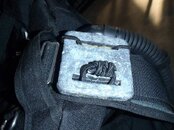I do not get the point you are trying to make @tbone1004 
You compared apples and oranges and that lead you to the wrong conclusion, it looks like.
Bungeeing a backmount style wing for sidemount serves two main purposes:
1. Reducing the flapping around of the empty and partially filled wing.
2. Forcing the air on the partially filled wing to concentrate at the hips, instead of the shoulders.
When you fill a wing bungeed like that to full capacity the inflator or oral inflation has to overcome the force and when it is filled at last you will loose all effect the bungees had on the wing.
When your trim fails suddenly most normally compensate by filling the wing an bit more, since this wing is already full, most will acctualy drop a few meters in the progress I think.
Anyway: the bungee is meant to restrict the wing a bit, either it will, or it can be removed, since it does not help then.
Since you mentioned the Razor let my try to explain that part again:
When the Razor is bungeed too tightly the wing will not inflate to maximum capacity before the bungee cuts into you to much.
At the same time the weight pieces below the wing are pressed into it and reduce it's capacity before the overpressure valve starts to burp.
It is something one has to take into account when diving a sidemount system (most or probably all) with a large wing and lots of weight attached.
You compared apples and oranges and that lead you to the wrong conclusion, it looks like.
Bungeeing a backmount style wing for sidemount serves two main purposes:
1. Reducing the flapping around of the empty and partially filled wing.
2. Forcing the air on the partially filled wing to concentrate at the hips, instead of the shoulders.
When you fill a wing bungeed like that to full capacity the inflator or oral inflation has to overcome the force and when it is filled at last you will loose all effect the bungees had on the wing.
When your trim fails suddenly most normally compensate by filling the wing an bit more, since this wing is already full, most will acctualy drop a few meters in the progress I think.
Anyway: the bungee is meant to restrict the wing a bit, either it will, or it can be removed, since it does not help then.
Since you mentioned the Razor let my try to explain that part again:
When the Razor is bungeed too tightly the wing will not inflate to maximum capacity before the bungee cuts into you to much.
At the same time the weight pieces below the wing are pressed into it and reduce it's capacity before the overpressure valve starts to burp.
It is something one has to take into account when diving a sidemount system (most or probably all) with a large wing and lots of weight attached.
Last edited:





